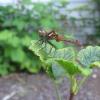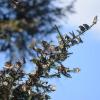With the release of a paper studying the effects of climate change on bumble bee ranges, this blog is intended to help interpret the results of the study, provide some context for the results, and examine how they may affect the conservation landscape.
On Thursday July 9, 2015, a paper about the effects of climate change on bumble bee ranges was published in the journal Science by Dr. Jeremy Kerr and several colleagues. This is an impressive body of research and does much to further our understanding of landscape-scale effects on insects. Understandably, this research has garnered a lot of attention from national news outlets, as well as the scientific and conservation communities. Here at the Xerces Society we have taken particular note of its conclusions as they will help to inform our research and restoration efforts in the years to come. This blog is intended to help interpret the results of this study, provide some context for these results, and examine how they may affect the conservation landscape.
While these results are impressive, and exemplify an important body of work, we believe that they should be interpreted in the context of what we know about bumble bee conservation as a whole — at least here in North America. Large-scale bumble bee declines were first detected in the mid-1990s thanks to the work of Dr. Robbin Thorp (Professor Emeritus, UC Davis). While studying bumble bees in northern California and southern Oregon, Dr. Thorp documented the sharp decline of two once-common species, Franklin’s bumble bee and the western bumble bee. Since then, Dr. Thorp’s work has raised awareness about bumble bee declines in North America. This has spurred countless research efforts here in the New World, while parallel efforts have developed in Europe and beyond.
These bumble bee research efforts have identified many likely causes for bumble bee declines. For the past decade, the leading hypothesis for the declines of several of our North American species has been that pathogens harbored by commercial bumble bees spread to multiple species of their wild counterparts, leading to dramatic declines — most notably in the rusty patched bumble bee, the western bumble bee, and Franklin’s bumble bee. I cannot speak for the entire bumble bee research community, but in my opinion, the Kerr et al. paper does not change that conversation for the most severe declines that we have seen in North America. The timing, scope, and severity of the declines of those species (and likely several other species in the subgenus Psithyrusthat depend on those species as hosts) is likely far too severe to be explained by climate change alone. Pathogens have also been implicated in the dramatic decline of the world’s largest bumble bee, Bombus dahlbomii, in South America. Unfortunately, and probably because of a lack of available geospatial data on bumble bee pathogens, the Kerr et al. paper did not consider the role of pathogens in bumble bee range losses.

In addition to the pathogen hypothesis, many other reputable studies have documented additional factors that can be implicated in the bumble bee declines being observed worldwide. The most notable of those factors include habitat loss, emergence time, and the use of herbicides and insecticides. The Kerr et al. paper does not disprove or prove any of those factors. In fact, in personal correspondence, Jeremy Kerr, the lead author of this study stated that “we did not disprove the harmfulness of neonicotinoids to bumble bees in this study, nor do we suggest that climate change is the only factor affecting bumble bee species’ ranges.”
This study does provide evidence to support the idea that bumble bees are affected by a warming climate — and perhaps most notably, that they, unlike some other taxa, will experience contractions from the south, without the potential for expansion to the north. While the models that the Kerr et al. team built show patterns of decline advancing from the south, which are correlated with climatic patterns, they do not definitively determine a single mechanism to explain those patterns. In addition to climate change, there are likely many concurrent factors working together to drive the large-scale declines we have seen in the overall ranges of several species of bumble bees. This is particularly important from a conservation perspective because while climate change may be a driver of emerging patterns, those patterns might look very different — or at the very least, might advance more slowly — if we eliminated the other stressors that bumble bees are facing.
If one takes the Kerr et al. conclusions outside of this greater context, one might conclude from their study that bumble bees are doomed to a long, slow decline, as southern areas warm beyond the thermal physiological limits of bumble bees. Kerr et al. suggest at the very end of their paper that experimental relocation may be a way to mediate this potential long, slow decline by helping bumble bees move northward more quickly. We strongly urge all researchers and practitioners to exercise caution before attempting this approach. One does not have to look far — in fact, not even outside of bumble bee research — to see the damaging effects that the anthropogenic movement of animals outside of their ranges can have on the native species with which they interact.
Instead of experimental relocation, the Xerces Society would suggest several different approaches to ensure that our bumble bees are around for generations to come. If it is indeed true that bumble bees are being lost from the southern edges of their ranges, but not expanding northward, then the importance of conserving existing bumble bee habitat is underscored. Since this research suggests that we are not likely to find bumble bees in new places in the future, we should become better stewards of our land. Prairies and grasslands previously used by bumble bees have been converted to agricultural fields, subdivisions, and grazing pastures. Areas that were once predictable resources for bumble bee queens to build their nests are now blooming earlier because of a changing climate, or are laced with toxic insecticides providing consistent, but sublethal doses of poison. If we don’t do a better job of protecting the bumble bees that are currently flying around our landscape, they don’t stand a chance of migrating northward.
Before we even consider experimental relocation, we suggest that a concerted and focused effort — at a continental scale — should be made to conserve, protect, restore, and create a landscape that more closely resembles the world in which bumble bees evolved. Bumble bees’ needs are not great, and generally are concordant with what people need to survive. In short, they need three things:
- Safe places to build their nests and to overwinter.
- Floral resources from early spring through fall.
- A pesticide-free environment.
The Xerces Society has dedicated a major part of its efforts over the last 15 years to the protection of bumble bees and other insect pollinators. We now have the largest team of pollinator conservation specialists of any organization in North America, who work everyday with farmers and land managers to create new habitat. In addition, our website provides an extensive set of resources to help land managers, landowners, and gardeners to build this landscape, no matter the area of land that is being developed. You can find these resources at www.BringBackThePollinators.org. We have also written a set of habitat management guidelines specifically for bumble bees. You can access those guidelines here.
Another meaningful way to contribute to conservation efforts is to submit photos of bumble bees to BumbleBeeWatch.org. These records will help Xerces Society scientists and other researchers to continue to track potential shifts in range, identify the location of extant populations of imperiled species, and target those areas for bumble bee-focused habitat management and enhancement.
A changing climate is likely to affect all species. What the Kerr et al. paper helps us to understand that not all species are going to respond to forthcoming changes in climate in the same way. Thus, other than efforts to curb the rate at which our climate changes, there is no one thing that we can do to help species adapt to the changes that are coming. However, if we as a society make an effort to protect, conserve, and restore our open spaces into lands that resemble functioning ecosystems, it will not only benefit bumble bees and other pollinators, but also create a landscape in which all species can thrive. If we reduce the number of stressors that all species face, we will create landscapes that will be more hospitable now, and provide a refuge — and hopefully ample time — for plants and animals to adapt and evolve in response to the pressures of a changing climate, without the additional threats and anthropogenic forces that are surely driving species declines and extinctions.




